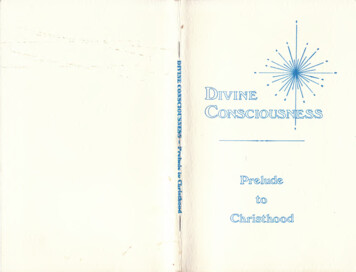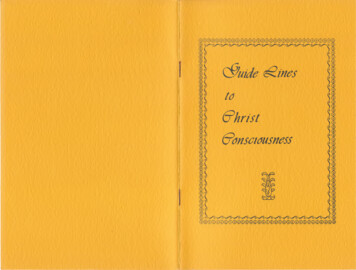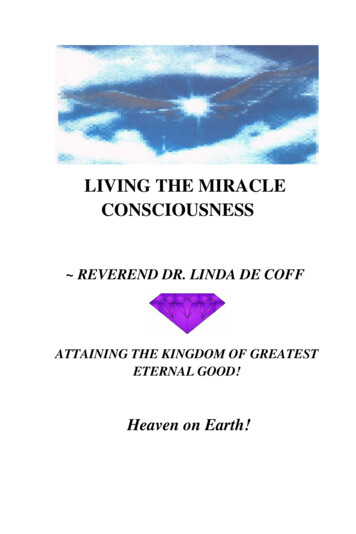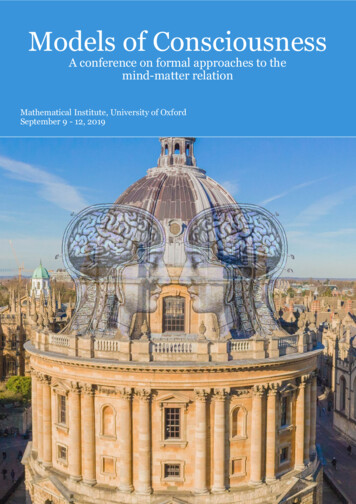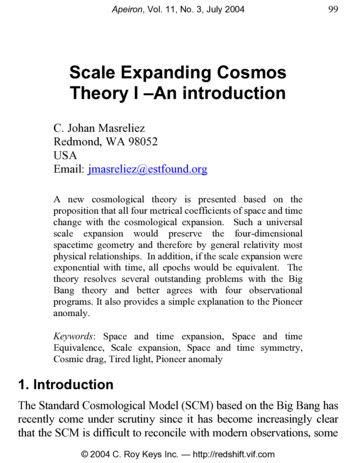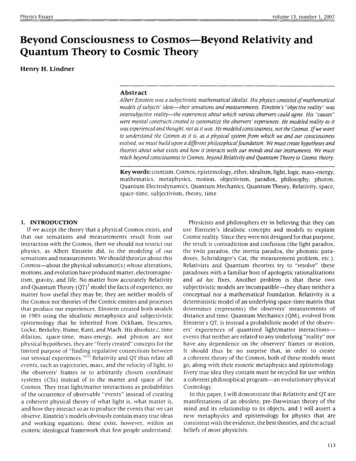
Transcription
Physics Essaysvolume 15, number 1, 2002Beyond Consciousness to Cosmos Beyond Relativity andQuantum Theory to Cosmic TheoryH e n r y H. L i n d n e rAbstractAlbert Einstein was a subjectivistic mathematical idealist. His physics consisted of mathematicalmodels of subjects' ideas--their sensations and measurements. Einstein's "objective reality" wasintersubjective reality--the experiences about which various observers could agree. His "'causes"were mental constructs created to systematize the observers' experiences. He modeled reality as itwas experienced and thought, not as it was. He modeled consciousness, not the Cosmos. I f we wantto understand the Cosmos as it is, as a physical system from which we and our consciousnessevolved, we must build upon a different philosophical foundation. We must create hypotheses andtheories about what exists and how it interacts with our minds and our instruments. We mustreach beyond consciousness to Cosmos, beyond Relativity and Quantum Theory to Cosmic theory.Key words: cosmism, Cosmos, epistemology, ether, idealism, light, logic, mass-energy,mathematics, metaphysics, motion, objectivism, paradox, philosophy, photon,Quantum Electrodynamics, Quantum Mechanics, Quantum Theory, Relativity, space,space-time, subjectivism, theory, time1. INTRODUCTIONIf we accept the theory that a physical Cosmos exists, andthat our sensations and measurements result from ourinteraction with the Cosmos, then we should not restrict ourphysics, as Albert Einstein did, to the modeling of oursensations and measurements. We should theorize about thisCosmos--about the physical substance(s ) whose alterations,motions, and evolution have produced matter, electromagnetism, gravity, and life. No matter how accurately Relativityand Quantum Theory (QT) l model the facts of experience, nomatter how useful they may be, they are neither models ofthe Cosmos nor theories of the Cosmic entities and processesthat produce our experiences. Einstein created both modelsin 1905 using the idealistic metaphysics and subjectivisticepistemology that he inherited from Ockham, Descartes,Locke, Berkeley, Hume, Kant, and Mach. His absolute c, timedilation, space-time, mass-energy, and photon are notphysical hypotheses, they are "freely created" concepts for thelimited purpose of "finding regulative connections betweenour sensual experiences. ''{1) Relativity and QT thus relate allevents, such as trajectories, mass, and the velocity of light, tothe observers' frames or to arbitrarily chosen coordinatesystems (CSs) instead of to the matter and space of theCosmos. They treat light/matter interactions as probabilitiesof the occurrence of observable "events" instead of creatinga coherent physical theory of what light is, what matter is,and how they interact so as to produce the events that we canobserve. Einstein's models obviously contain m a n y true ideasand working equations; these exist, however, within anesoteric ideological framework that few people understand.Physicists and philosophers err in believing that they canuse Einstein's idealistic concepts and models to explainCosmic reality. Since they were not designed for that purpose,the result is contradiction and confusion (the light paradox,the twin paradox, the inertia paradox, the photonic paradoxes, Schr6dinger's Cat, the measurement problem, etc.).Relativists and Quantum theorists try to "resolve" theseparadoxes with a familiar host of apologetic rationalizationsand ad hoc fixes. Another problem is that these twosubjectivistic models are incompatible--they share neither aconceptual nor a mathematical foundation. Relativity is adeterministic model of an underlying space-time matrix thatdetermines (represents) the observers" measurements ofdistance and time. Quantum Mechanics (QM), evolved fromEinstein's QT, is instead a probabilistic model of the observers' experiences of quantized light/matter interactions-events that neither are related to any underlying "reality" norhave any dependence on the observers' frames or motion.It should thus be no surprise that, in order to createa coherent theory of the Cosmos, both of these models m u s tgo, along with their esoteric metaphysics and epistemology.Every true idea they contain must be recycled for use withina coherent philosophical program--an evolutionary physicalCosmology.In this paper, I will demonstrate that Relativity and QT aremanifestations of an obsolete, pre-Darwinian theory of themind and its relationship to its objects, and 1 will assert anew metaphysics and epistemology for physics that areconsistent with the evidence, the best theories, and the actualbeliefs of most physicists.113
Beyond Consciousness to Cosmos--Beyond Relativity and Quantum Theory to Cosmic Theory2. DEFINITIONSPlease bear with me while I present some crucial definitions; without them, everything I say about Einstein's workcan be misunderstood and misconstrued. This is a difficultphilosophical problem and, like most such problems, itpersists and appears irresolvable because it is mired inambiguous terminology. To eliminate this problem in thiscase, I must expose the central issue that "modern philosophy" has evaded for several centuries. I must expose thephilosophical bedrock--the two underlying, mutuallyexclusive theories about what exists, how it relates to ourconscious experience, and how we should study it:idealism: Consciousness exists. All that we know withcertainty is that we are conscious--we passively experienceand actively create ideas. The existence of anything apartfrom our ideas is uncertain and unknowable.Cosmism: The Cosmos exists. It is the self-sustainingphysical entity of whose evolution we humans and ourlanguage-enhanced consciousness are products. Our sensationsand measurements result from the physical interaction of oursense organs and instruments with the rest of the Cosmos.These mutually exclusive metaphysical postulates producedifferent epistemologies:-subjectivism: Knowledge consists only of our descriptionsand models of our conscious experiences.objectivism: Knowledge consists of our attempts to describe,model, and explain the Cosmos itself, as it exists and evolvesand causes our experiences.These metaphysical/epistemological alternatives have beencalled the "primacy of consciousness" and the "primacy ofexistence. ''(2) Idealism holds that our minds participate in amental/spiritual reality that is separate from and independentof any physical, biological, or neurological reality. It hasproduced subjectivism, skepticism, spiritualism, mentalism,empiricism, phenomenalism, and positivism. Cosmism, onthe other hand, asserts that everything, including ourlanguage-enhanced consciousness, is a product of theevolution of the Cosmos. Cosmism has produced objectivism,realism, naturalism, materialism, and evolutionary theory.In theoretical physics, these two distinct theories of realityand its relationship to our conscious experience prescribe twodifferent ways to acquire concrete factual knowledge:We are curious creatures. Not content to merely describethings, we construct models that can account for the regularities we observe. There are again just two approaches:s u b j e c t i v i s t i c m o d e l i n g : Regularities are noted among theobserved events and measurements in the subject's CS. Theobserver then constructs a system of assumptions about whathe measures and, using this system, finds the "laws" andequations that fit his observations and successfully predictfuture observations. The result is a model of the entities andevents in the observer's experiential "world" or CS.objectivistic modeling: Regularities are noted amongevents and measurements as these are related to Cosmicentities and CSs. The observer finds the "laws" and equationsthat describe motion in the Cosmic CSs and that predictfuture observations. The result is a model of the Cosmos.Idealism and subjectivism have given us a physics limitedto subjectivistic modeling:Relativity: MI motion is merely relative to, and thereforeequally well related to, any observer or arbitrarily chosen CS.The "laws" of physics are the mathematical correlations ofmeasurements made by any observers in any CSs. Thefundamental entities, mass-energy and space-time, areobservers' measurements. A physical Cosmos that causes theobservers' experiences or affects the observers' instrumentsis a superfluous hypothesis.Q u a n t u m T h e o r y : The "laws" of physics are merely descriptions of our e x p e r i e n c e s - - m a t h e m a t i c a l instruments forpredicting the probability that one set of observations will befollowed by a certain second set of observations. Sourcesproduce neither physical waves nor particles, but onlyprobabilities that an observed event will produce a subsequent observed event in a certain location at a certain time.Consciousness is the only reality. There is no underlyingphysical reality to describe or explain.Cosmism and objectivism, however, allow additional levelsof investigation and cognition:Cosmic theory: The attempt to explain our existence andsubjectivistic description: The observer merely describesexperiences as caused by observed and unobserved entitiesand processes.Cosmic p h i l o s o p h y ( n a t u r a l , s c i e n t i f i c ) : The creation andcriticism of theories to explain all phenomena, the practicalapplications of these theories, and the mental tools andtechniques required for these tasks.his experiences--what he senses with and without instruments. Since no physical Cosmos exists or can be known, hecan only relate these events to his own frame of referenceor CS.objectivistic description: The observer posits a Cosmos andCosmic entities and CSs that play a unique and causal role inwhat she experiences. She relates her measurements andexperienced events to these Cosmic CSs.Allow me to illustrate the above definitions with thehistory of theoretical physics. The Aristotelian and Ptolemaicgeocentric system was an objectivistic model of the Cosm o s - - a n attempt to model what existed prior to and apartfrom any observer. However, it naively presumed that theobserver's accidental frame, Earth, was motionless in thecenter of the Cosmos. This system required the rotation of thell4
Henry H. Lindnerrest of the Cosmos and needed many complicated devices tomodel the planets' motions. To make sense of the Cosmos asa physical system, Copernicus posited instead that Earthrotated and moved about the Sun, even though humans couldnot directly sense or measure these motions. This required acognitive leap from the subject's experience in her own CS toan objectivistic model of motion in a Cosmic CS--a theory ofwhat was happening in the Cosmos to produce the subject'sexperiences--a leap from the known (experience) to theunknown (Cosmos). Opponents argued that this leap wasunjustified because observers experienced no such mot i o n s - t h e y felt no spatial "wind." However, we know thatCopernicus was correct and that all subsequent advances inCosmology and physics required this shift from the Earth CSto the Sun-Star CS. It enabled Kepler to discover the ellipticalshape of the orbits, which enabled Newton to demonstratethat the motion of our Moon and planets was caused by thesame gravity that we experience on Earth. Newton's physicswas also objectivistic in that it related all motion not to thehuman observer's CS but to a Cosmic CS. His absolute spacewas a static, Euclidean, universal ether that resisted theacceleration of matter and in which all matter had somedefinite velocity, even if it could not be determined. O) JamesMaxwell added to this ether the property of propagatingelectromagnetic (EM) waves at c. Michelson and Morley(M-M) then tried to detect the velocity of the Earth throughit using the interference of light waves traveling in differentdirections. They sought the very same "wind" assumed byCopernicus's opponents. When they failed to detect it, theCopernican debate was resurrected: Is Earth really movingthrough Cosmic space? Stokes responded to the null M-Mresults with the theory that Earth entrained its surroundingspace into its own motion--that the spatial ether was notstatic but some kind of gas or fluid whose position andmotion were dynamically influenced by matter. HendrickLorentz tried to save Newton's static universal space bytheorizing that the null M-M results were an illusion causedby the effects of static space on the moving apparatus. Heproposed that objects moving through the ether suffered aphysical length contraction and reduction in frequency thatmade the detection of absolute motion impossible. Heproduced equations to describe these alterations. The possibleobjectivistic explanations of the null M-M results were in noway exhausted. Einstein, however, attempted to implementa completely different metaphysical and epistemologicalprogram. He concluded that the null M-M experimentsimplied that there was no physical space through whichEarth was moving--that Earth was not "really" moving atall. He asserted that the ether hypothesis was "superfluous"and that all motion was merely relative--the trivial consequence of one's choice of CS. He reproduced Lorentz's etherequations but applied them only to the comoving CSs. Hethus eliminated the middle ethereal term and any possiblephysical explanation of these effects. He related all motionand laws of motion to any observer's or any chosen CS, not tothe matter and space of the Cosmos. He attempted only tofind the simplest set of ideas that would describe and predictthe observer's experiences and measurements. He thusabandoned objectivism and physical theory in favor ofsubjectivistic modeling. His 1905 papers on Relativity and thelight quantum put the existence of the physical Cosmos, itsphysical substance(s), and the causes of all physical phenomena outside the purview of Science. Einstein claimed that hehad reversed the Copernican revolution--that Relativitymade the historic struggle between the views of Ptolemy andCopernicus "meaningless" since it was only a matter of one'schoice of CS. (41 In fact, if we want to model and to understand the Cosmos, we must again take the Copernican leapfrom observations to Cosmos.I know that some readers will protest that Relativity andQT are not "subjectivistic" because they deal only with factsand measurements and have no element of personal whim orbias. However, the "subjectivity" they speak of is not the"subjectivism" of philosophical parlance defined above. I donot charge Relativity and QT with a naive psychological orperceptual subjectivity. Instead, epistemological subjectivismassumes the observer's accurate accounting of his experiencesand measurements, including instrumented measurements,within his CS, even as recorded by mini-observers at everypoint of his CS. The argument is thus an equivocation--anattempt to confuse two different concepts.3. A BRIEF HISTORY OF SUBJECTIVISMWhy did Einstein resort to subjectivistic modeling? Howdid this highly restricted epistemology come to dominatephysics? Why don't we abandon his approach and insteadcreate objectivistic models and physical theories of Cosmicspace, matter, and motion? These questions must be answered at two levels: the practical and the ideological.Practically, in the wake of the null M-M experiments,scientists were understandably dissatisfied with the Newtonian/Lorentzian theory of a single static ethereal space, buthad none of the information or tools needed to create aworking dynamic theory of space, light, and gravity. They didnot know what we know today about the behavior of light,atoms, and atomic clocks at rest or in motion among thecelestial bodies of this Cosmos. Theoretical physics was at animpasse. Einstein cut this Gordian knot by abandoningobjectivism and causal theory altogether. He greatly simplified physics by dealing only with appearances and measurements, thus evading the difficult questions of the causes ofCosmic phenomena. Why did most other scientists eventuallyaccept this approach? Why does it persist today? To answerthe ideological question, we must briefly review the historyof Cosmic philosophy and of its nemeses--idealism andsubjectivism. We will then discuss the application of theseideas in Special Relativity (SR), General Relativity (GR),and QT.Philosophy originated in Ionia in the 6th century B.C.when Thales of Miletus theorized that all physical entitiesand processes were the result of changes in and of water. Thishistoric conjecture replaced traditional mythological Cosmol115
Beyond Consciousness to Cosmos--Beyond Relativity and Quantum Theory to Cosmic Theoryogies with naturalistic theory. It began a program of openended, nondogmatic theorizing about the nature of theCosmos and of the causes of things. Thales's own colleaguesposited other substances as f u n d a m e n t a l to the Cosmos.Later, on the Greek mainland, Leucippus and Democritustheorized that the Cosmos and all its manifestations were theresult of invisible atoms flying through a void. Of course,these early theorists had little of the knowledge we havetoday. Their theories were thus inadequate and full ofdifficulties.Socrates' early interest in Cosmic theory gave way to adisappointed skepticism. The problems he encountered insuch theories made him doubt the efficacy of all materialisticexplanations and even of his own senses. He decided to "takerecourse to the world of mind and seek there the truth ofexistence. ''l l Aristippus, a follower of Socrates, developedSocrates skepticism. His Cyrenaic school rejected Cosmictheory, arguing that h u m a n s could only know their ownsensations and experiences and could not have any knowledge of the external world. Protagoras, the earliest knownsophist, argued further that "Man is the criterion of allobjects, of those which exist that they exist, and of those thatexist not that they exist not." Of him it was said "he positsonly what appears to each individual, and thus he introducesrelativity. ''(6) Aristotle opposed the skepticism, subjectivism,and relativism of these thinkers with m a n y arguments:For sensation is surely not the sensation of itself, but there issomething beyond the sensation, which must be prior to thesensation;for that which moves is prior in nature to that whichis moved . {7)He demonstrated that subjectivism produces contradictionsince it cannot account for illusions and because subjectsmust always disagree on what they experience and measure.In another passage, he states,But if not all things are relative, but some are self-existent, noteverything that appears will be true; for that which appears isapparent to someone; so that he who says all things that appearare true, makes all things relative. {a)Aristotle argued that gravity was proof that all motion wasnot merely relative, as objects gravitated Earthward regardless of the position of the observer or the choice of frame, (9)an argument no less cogent today. Later, Isaac Newton alsorejected subjectivism in physics:But because the parts of space cannot be seen, or distinguishedfrom one another by our senses, therefore in their stead we usesensible measures of them . And so, instead of absolute spacesand motions, we use relative ones; and that without anyinconvenience in common affairs; but in philosophical disquisitions, we ought to abstract from our senses and consider thingsthemselves, distinct from what are only sensible measures ofthem.(1 116Aristotelian philosophy and Christianity were married inthe Dark Ages, but with the discovery of Aristotle's works ofnatural philosophy, c h u r c h m e n perceived a threat to theirbeliefs and the marriage became strained. Thomas Aquinasattempted to reconcile the partners, but could not prevent theinevitable divorce. In 1277, just three years after Thomas'sdeath, the Bishop of Paris issued a condemnation of m a n yAristotelian-Thomist theses. This divorce was accompaniedby a religious backlash against Aristotle and all naturalphilosophy. William of Ockham (b. 1280) tried to corn pletelyfree theology from Cosmic philosophy. To do so, he limitedphilosophy to the mere description of experience. Againstphysical causation and evolution, he stressed the omnipotence of God and the radical dependence of all created thingsupon God for both their existence and interaction. ForOckham, there was a created world, but there were no Godindependent physical entities or processes. Therefore, tostudy nature was to study God's free acts. Ockham thereforeinsisted that we should only describe our actual experiencesusing the fewest propositions necessary; we should only notethe regular sequences of observed events, not hypothesizeabout any God-independent natural causes or mechanisms.For Ockham, experience-based propositions, not Cosmicentities and processes, were the proper objects of knowledge. (11) The purpose of Ockham's Razor was clear--toeliminate all complex, hypothetical theories of physicalentities and causation in favor of the simplest explanation ofthe cause of all experienced p h e n o m e n a - - G o d .Ren4 Descartes went one step further toward spiritualsubjectivism. He sought to confine knowledge to what wasgiven to us by God and about which we could be c e r t a i n - - t h e"clear and distinct ideas presented to the senses." His Cogitoergo sum, "I think, therefore I am," tacitly assumed ideali s m - - t h e primacy of consciousness--that consciousnessexisted prior to, and independent of, the h u m a n body and thephysical Cosmos. The apparent Cosmos could, he supposed,be a hallucination produced in his mind by some demon. (12tDescartes was persuaded to believe in the existence of thephysical Cosmos because it appeared to exist and he believedthat God would not so deceive him if it were not so. However,he believed in "external" things only insofar as they weremanifestations of geometrical and mathematical forms. Inorder to avoid error, Descartes asserted that we must shun alltheorizing about physical entities and causes and confineourselves to mathematical descriptions. He implied thattheorizing about the final (Cosmic) causes of things was asin. {13 He advised that we pursue the only certain, indubitable knowledge available--the mathematical description ofour sensations--universal mathematics. To this purpose,Descartes invented the familiar three-axis CS that representsspace as a three-dimensional geometric matrix.John Locke was also more certain of spiritual than ofphysical existence./14) He claimed that we could only knowthe ideas that were presented to us by our senses and couldnever pass beyond them to any knowledge of the nature orhidden causes of things./15) Descartes and Locke were thus
Henry H. Lindnerdualists, believing in the existence of two substances-spiritual and physical. Since they k n e w very little aboutphysical reality or the h u m a n mind, they could not producea good theory of how these two kinds of reality coexisted andinteracted. They could not explain what matter was or howit interacted with "spirit." They therefore defaulted tothe simpler, immediately accessible, conscious/spiritualperspective (idealism-subjectivism) and tried to discourageall theorizing about the unseen physical causes of phenomena.Bishop Berkeley (circa 1710) completed the move towardidealism and subjectivism and away from Cosmic philosophy.In his post-Copernican, post-Newtonian world, he feared thatas more and more p h e n o m e n a were explained by naturalcauses acting in a physical Cosmos, faith in the God ofChristianity would gradually give way to materialistic naturalphilosophy (and this was before Darwin). He saw all philosophical explanation as a slippery slope leading to atheism,so he tried to replace Cosmic philosophy with a purelydescriptive approach to knowledge that had no need for theCosmos or for physical causation. He rejected Descartes andLocke's dualism because it admitted the existence of aphysical Cosmos and thus left the door open to naturalphilosophy. He argued instead that since we h u m a n s knowonly our own conscious experiences and have no directknowledge of any material Cosmos, we must not assume thatit exists. ( 6) He argued that we should accept the simplertheory that all reality is purely spiritual; (17) that our experiences are not caused by any physical world but are a virtualreality provided directly to our (disembodied) minds byGod./ a) Berkeley argued, for instance, that people would notworship the Sun once they realized that it was not anindependently existing physical entity, but merely a Godgiven apparition. (19) Berkeley asserted that the laws of opticswere God's means of creating the visual illusion of distancein our hallucinatory consciousness, an illusion properlycoordinated with illusions of our own motion and actionwithin this virtual space. Ix (An analogue of Berkeley'stheory of consciousness was recently presented in the film,TheMatrix. In) In it, h u m a n s believe that they are experiencingnormal life in the physical world w h e n in reality their bodiesare lying in vats, their brains are hardwired to a mastercomputer, and their minds are interacting with each other'swithin a computer-generated virtual reality. Berkeley'sMatrix likewise consisted of individual h u m a n spiritsinteracting with each other within a God-generated spiritualreality. )Berkeley publicly accused Newton of advocating anatheistic theory, because Newton's absolute space, absolutetime, and physical matter were supposed to exist "withoutthe mind" and thus without God. t22) Echoing Ockham,Berkeley argued that since God alone makes one experiencefollow another, philosophy should merely note these regularities and not pretend to explain things by corporeal causes./23)He argued that gravity was not an essential quality inherentin bodies but was simply a motion entirely dependent on thewill of G o d - - w h o causes some bodies to tend toward eachother, others to stay at fixed distances, and others to flyasunder as He sees convenient.124) Against Newton, he arguedthat we should treat motion not as absolute, Cosmic, or realbut as merely relative to ourselves and to any other objects inour sensoria, (25) and treat time as the mere succession ofevents in our consciousness. (26)Following Berkeley in this "Enlightenment," David H u m edenied that we could know any Cosmic causes, saying thatour belief that an effect will follow from a cause is merely a"custom" we have acquired through repetitive experience. 127)He denied that we could ever know the cause of such a"custom" as gravity. 128)Like Berkeley, he reduced the Cosmosand its causes to correlations among experiences. I m m a n u e lKant agreed that we could only know the phenomena presented to our senses and could never pass beyond them toany knowledge of the noumena--things in themselves. Kantclaimed that the mind imposed its own order on p h e n o m e n ausing a priori categories like space, time, and causality. Thesecategories were ideals that were not inductively gained fromexperience but were innate mental structures.Ernst Mach admitted his debt to Berkeley and Hume. (29)He stated, "The world consists only of our sensations. '' 176Heasserted that the aim of Science was to describe our sensations and that the laws of Science merely stated generalrelationships among our sensations. Anything not directlyperceived did not exist; unapparent entities posited to causesensations were mere "metaphysical speculations"--nothingmore than convenient fictions. Therefore, Mach, as late as theearly 20th century, denied the existence of atoms becausethey could not be seen, even though they were a necessarypostulate in any attempt to explain our experiences. Machredefined physical theories as mere quantitative instrum e n t s - m a t h e m a t i c a l models for facilitating the mentalreproduction and prediction of facts. Mach wrote extensivelyand greatly influenced the scientists and philosophers of thelate 19th and early 20th centuries. His idealist ideology,under the names "sensationalism," "phenomenalism," and"positivism," was considered the modern and enlightenedapproach to Science at the turn of the last century. In 1883,Mach followed Berkeley in branding Newton's theory ofabsolute space and motion as "devoid of content," sayingthat we have knowledge only of relative spaces andmotions. ''13 ) He called those who shared his view "relativists.,,O 2)Mbert Einstein had a lifelong interest in p h i l o s o p h y - - h ehad read Kant as a boy, he had read Berkeley, and headmitted that H u m e and Mach influenced his development. O3) So we can understand why he asserted,The only justification for our concepts and system of concepts isthat they serve to represent the complex of experiences; beyondthis they have no legitimacy. 04)Following Berkeley, Einstein eschewed Cosmic theory andnatural philosophy in favor of descriptive Science, which he117
Beyond Consciousness to Cosmos--Beyond Relativity and Quantum Theory to Cosmic Theoryregarded as "methodical thinking directed toward findingregulative connections between our sensual experiences. '' Einstein shared Berkeley's belief in God as "a superior mindthat reveals itself in the world of experience. ''O6) LikeDescartes, Einstein was a mathematical idealist--believingthat "nature is the realization of the simplest conceivablemathematical ideas. ''O7) He sought, therefore, to grasp themathematical ideas by which God created our experiences bydiscovering the fewest and simplest "laws" that couldaccount for them. Following Berkeley, Einstein defined the"real external world" intersubjectively, as the sum total of allexperienced events about which subjects can agree. O 1Following Berkeley and Mach, Einstein initially refused tobelieve that space itself had any physical qualities because itwas not directly evident to our senses or instruments.Einstein's Relativity and the QT were thus faithful implementations of Bishop Berkeley's vision of Science
Einstein's "objective reality" was intersubjective reality--the experiences about which various observers could agree. His "'causes" were mental constructs created to systematize the observers' experiences. He modeled reality as it was experienced and thought, not as it was. H


